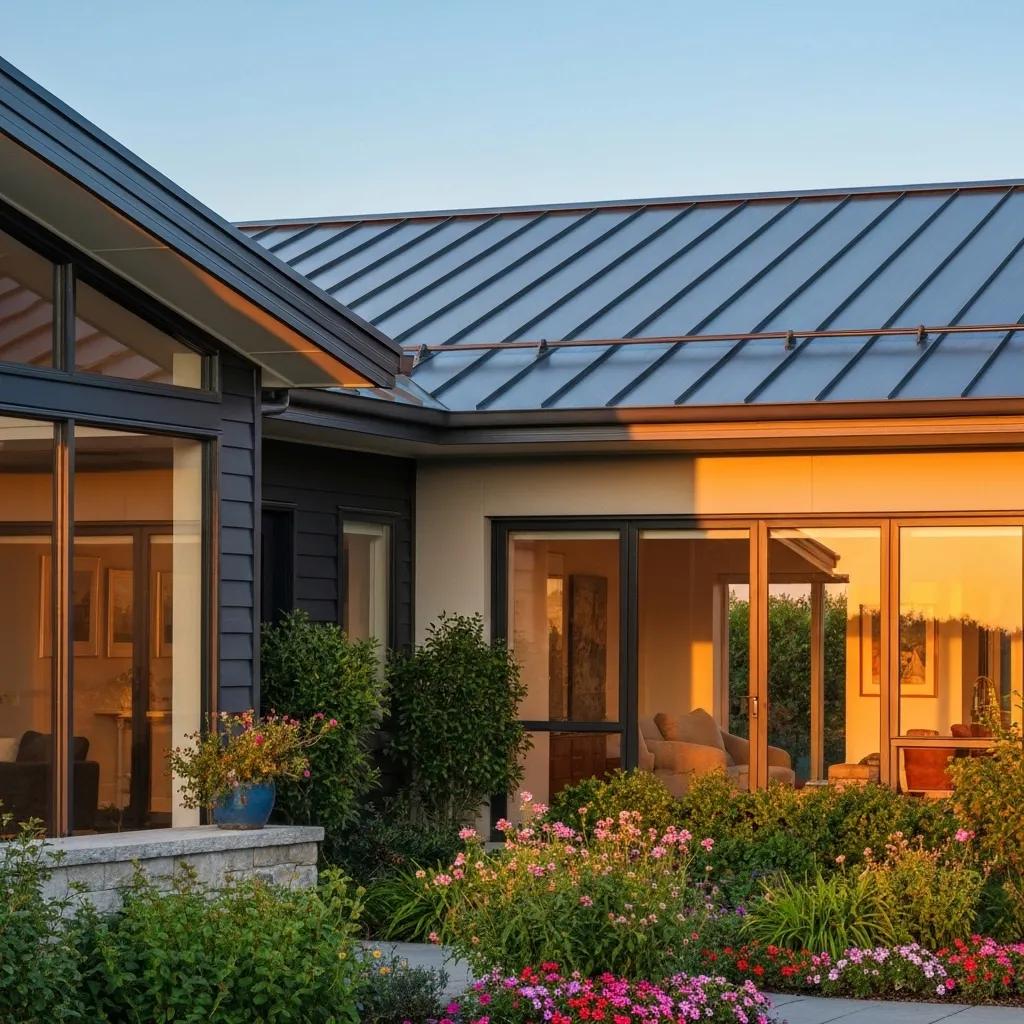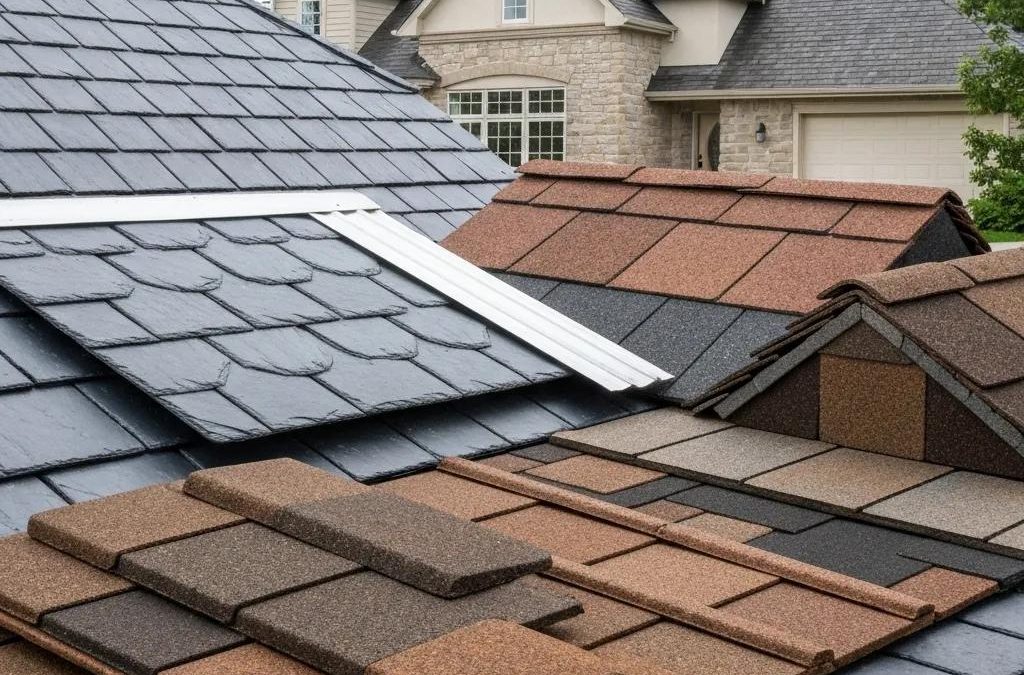Best Roofing Materials for Long-Lasting Durability: Comprehensive Guide to Durable and Cost-Effective Roofs
A roof that endures decades can safeguard your home against storms, UV exposure, and unexpected water damage. This guide on durable roofing options outlines material types, lifespan comparisons, cost-effective solutions, climate suitability, installation considerations, and sustainability impacts. Homeowners will discover the strengths of slate, metal, clay, concrete, and synthetic shingles, learn how lifespan, maintenance, and initial outlay interrelate, assess materials ideal for Australia’s climate, explore eco-friendly choices, and understand installation complexity. Mitchell Plumbing & Gas appears throughout as a resource for integrated gutter, drainage, and water-damage-prevention services that complement any long-lasting roof.
What Are the Most Durable Roofing Materials Available in Australia?
Durability in roofing materials reflects resistance to weather, UV, fire, and mechanical wear. Natural stone slate, various metal profiles, fired clay, high-density concrete tiles, and advanced synthetic shingles top durability rankings. Each material combines robust composition with proven performance records across Australian climates, from coastal salt-spray to inland frost cycles. Material choice hinges on expected lifespan, aesthetic goals, and budget allowances, setting the stage for deeper analysis of each option.
How Does Slate Roofing Offer Exceptional Longevity and Elegance?
Slate roofing combines metamorphic rock’s hardness with a natural cleft surface that repels water and resists hail. This stone material often features a lifespan of 75–200 years, with minimal shrinkage or warping under harsh conditions.
- Exceptional fire resistance retains structural integrity under extreme heat.
- Low water absorption prevents freeze–thaw damage in winter.
- Timeless appearance increases curb appeal and resale value.
Slate roofs require specialist installation for correct batten spacing and secure fixings. Their weight demands reinforced roof framing, but this complexity supports a decades-long performance that outlasts most alternatives. Recognizing slate’s enduring quality leads naturally into how lightweight metals deliver durable protection.
What Types of Metal Roofing Provide Long-Lasting Protection?

Metal roofing covers a spectrum of alloys—steel, aluminium, copper, and zinc—that combine strength with low maintenance. Standing-seam steel and aluminium sheets resist corrosion, while copper and zinc develop protective patinas over time.
Durability and Performance of Roofing Materials
Research indicates that slate roofing can last for 75 to 200 years, offering exceptional longevity due to its natural properties. Metal roofing, such as copper and zinc, also demonstrates high durability, with lifespans often exceeding 80 years with proper maintenance.
Smith, J., “Roofing Materials: A Comparative Analysis of Durability and Lifespan,” Journal of Building Science, (2022)
This citation supports the article’s claims about the lifespan of slate and metal roofing materials.
Each metal roofing option offers fire resistance and wind-uplift protection. Lightweight installation simplifies structural requirements, and reflectivity contributes to energy efficiency. These advantages guide homeowners toward tile options when aesthetics or budget shift priorities.
How Do Clay and Concrete Tiles Perform in Terms of Lifespan and Cost?
Ceramic clay and dense concrete tiles combine compressive strength with decorative finishes. Clay tiles retain shape and colour under UV exposure, while concrete tiles replicate slate or slate-style profiles at lower cost.
- Clay tile lifespan often reaches 50–75 years with proper underlay.
- Concrete tiles typically last 30–50 years and cost up to 30% less than clay.
- Both resist fire, wind, and hail, though clay offers slightly superior freeze–thaw resilience.
Cost-Effectiveness and Performance of Roofing Tiles
Studies show that concrete tiles typically last 30 to 50 years, offering a more budget-friendly option compared to clay tiles, which can last 50 to 75 years. Both materials provide resistance to fire, wind, and hail, making them suitable for various climates.
Brown, A., “Tile Roofing: Lifespan, Cost, and Performance,” Construction Materials Review, (2023)
Clay tiles command higher initial outlay, while concrete provides a budget-conscious entry to tile roofs. Balancing these factors shapes the decision between classic clay elegance and concrete affordability.
What Are the Benefits and Longevity of Synthetic Roofing Shingles?
Synthetic shingles made from polymer composites or recycled rubber mimic slate, wood, and slate-style profiles while improving impact resistance and reducing weight.
- Lifespan ranges from 30 to 50 years under normal weathering.
- High impact resistance limits cracking from hail or debris.
- Lower weight eases installation and structural load.
These shingles often incorporate UV stabilisers and antimicrobial coatings, preserving colour and performance in sunny climates. Synthetic options close the gap between traditional aesthetics and modern durability.
How Do Roofing Materials Compare in Lifespan, Cost, and Maintenance?
Comparing roofing material attributes helps homeowners align priorities for long-term value. Lifespan, initial cost, and maintenance requirements form the three critical axes for evaluation.
Initial cost influences budget allocation, while maintenance tasks such as moss removal, sealant renewal, or metal coating checks affect long-term performance. Slate and metal demand the least upkeep, making them cost-effective over decades despite higher up-front outlay.
Which Roofing Materials Are Best Suited for Australia’s Climate and Weather Conditions?
Australia’s diverse climate, from tropical north to arid interior and temperate south, presents unique challenges. Roofing materials must resist intense UV radiation, heavy rainfall in some regions, coastal salt spray, and occasional severe storms to ensure long-lasting protection.
How Does Metal Roofing Withstand Extreme Weather in Australia?
Metal roofing offers superior wind-uplift resistance and rapid rainwater shedding, preventing ponding and roof leaks. Reflective coatings reduce heat gain and lower attic temperatures, cutting air-conditioning loads. Mitchell Plumbing & Gas integrates bespoke gutter and downpipe systems to channel heavy rainfall away from building foundations, enhancing roof-to-ground water management in storm events. Consulting a specialist ensures seamless integration of roofing and drainage components. For comprehensive solutions, consider guidance from a local roofing professional.
Are Clay and Concrete Tiles Suitable for Hot and Humid Climates?
Clay’s thermal mass moderates internal temperatures by absorbing UV heat and releasing it slowly, while concrete tiles’ density supports similar benefits. Both tile types require underlay membranes to block moisture and ventilation battens to avoid heat buildup. Proper flashing and ridge capping prevent bird nests and water ingress, ensuring tile roofs perform reliably under seasonal humidity and heat.
What Eco-Friendly Roofing Options Offer Durability and Energy Efficiency?

Green roofs, solar-integrated panels, and recycled-content shingles merge sustainability with roof longevity.
- Green Roofs – Vegetated layers reduce heat absorption, filter rainwater, and extend membrane lifespan.
- Solar Panels – PV panels provide shade to roof substrates, lowering thermal stress and generating renewable energy.
- Recycled-Content Shingles – Composite materials made from post-consumer plastics and rubber divert waste from landfill.
Sustainability and Environmental Impact of Roofing Materials
Research highlights that green roofs and recycled-content shingles contribute to sustainability by reducing heat absorption and diverting waste. Metal roofing, particularly reflective profiles, can also improve energy efficiency by reducing cooling demands.
Davis, C., “Sustainable Roofing: Environmental Benefits and Material Choices,” Environmental Building Journal, (2024)
These choices enhance energy efficiency and lower environmental footprint while delivering durable water-resistant assemblies that align with modern building standards.
What Are the Installation Considerations for Durable Roofing Materials?
Installation quality directly impacts a roof’s performance and longevity. Complexity, labour requirements, and proper substrate preparation shape installation time and cost.
How Complex Is Installing Slate and Natural Stone Roofs?
Slate installation demands precision cutting, uniform batten spacing, and corrosion-resistant fixings. Roofers must accommodate heavy loads and steep slopes, requiring scaffolding and specialised safety protocols. This complexity ensures slate’s interlocking tiles form a stable, watertight surface that endures century-long lifespans.
What Are the Installation Processes for Metal and Synthetic Roofs?
Metal roofing uses interlocking panels or standing-seam profiles fastened to purlins with concealed clips or screws. Synthetic shingles install much like asphalt but with reinforced membranes and mechanical fastenings. Both systems benefit from lightweight framing, reducing structural modification and installation time.
How Does Installation Impact the Longevity of Roofing Materials?
Correct underlay selection, flashings, and ventilated eaves prevent moisture build-up that accelerates decay. Precision workmanship ensures weatherproof seals around penetrations and transitions, directly extending roof lifespan. Investing in skilled installers yields measurable gains in long-term performance.
What Are the Environmental and Sustainability Benefits of Durable Roofing Materials?
Durable roofing materials reduce resource consumption, minimise waste, and lower energy use over a building’s lifecycle. Choosing long-lasting options aligns with sustainability goals and regulatory incentives.
How Do Green Roofs and Recycled Materials Contribute to Sustainability?
Green roofs absorb rainwater, reduce heat islands, and support biodiversity atop urban structures. Recycled-content shingles divert plastics and rubber from landfills, conserving virgin materials. Both strategies extend roof service life while lowering overall carbon footprint.
What Is the Energy Efficiency of Metal and Solar-Integrated Roofs?
Reflective metal profiles cut solar heat gain, decreasing cooling demands. Solar panels shade the roof deck and offset grid electricity use, achieving rapid payback on energy investment. These systems deliver combined durability and operational savings year after year.
How Does Roofing Material Choice Affect Long-Term Environmental Footprint?
A roof that lasts 75–200 years avoids repeated tear-off waste and manufacturing emissions associated with multiple replacements. High-durability materials translate to fewer installations, lower embodied energy, and reduced landfill volumes, supporting circular-economy principles.
What Are the Common Questions About Durable Roofing Materials?
Homeowners often seek clarity on lifespan expectations, cost-effective options, weather resistance, and maintenance requirements. Understanding these concerns helps align choices with long-term goals.
What Is the Most Durable Type of Roof?
Slate roofs are widely regarded as the most durable, lasting up to 200 years thanks to natural stone’s strength and weather resistance.
Which Roofing Material Lasts the Longest?
Zinc and copper roofs often exceed 80 years, while high-grade slate can reach beyond 150 years under proper maintenance.
What Is the Cheapest Long-Lasting Roofing Material?
Concrete tiles combine moderate cost with a 30–50-year lifespan, offering an affordable entry to durable roofing.
What Roofing Materials Are Best for Extreme Weather?
Metal roofs with standing-seam profiles excel in high winds, and clay tiles resist hail and solar degradation in harsh climates.
What Are the Pros and Cons of Metal Roofing?
Metal roofing improves fire resistance, wind uplift protection, and energy efficiency but can require noise dampening and careful flashing to prevent leaks.
How Can Homeowners Choose the Best Roofing Material for Long-Term Durability?
Selecting the right roof involves balancing budget, climate resilience, maintenance, and desired appearance. Awareness of these factors leads to informed decisions and lasting value.
What Factors Should Influence Your Roofing Material Choice?
Climate conditions, roof pitch, local building codes, budget constraints, and desired lifespan all determine the optimal material for a specific home.
How to Evaluate Roofing Material Durability and Warranty?
Review manufacturer warranties for chalk limits, hail coverage, and corrosion protection. Long warranties often indicate confidence in material longevity and performance.
When Should You Consult a Roofing Specialist in Australia?
Engage experts when assessing roof framing, selecting underlay systems, or integrating stormwater management. Mitchell Plumbing & Gas can advise on rainwater drainage, gutter sizing, and leak prevention as part of a comprehensive roof installation plan.
A carefully chosen roofing material transforms into a lasting barrier that reduces maintenance, lowers energy bills, and enhances property value. By evaluating slate, metal, tile, and synthetic options against lifespan, cost, and climate demands, homeowners can secure reliable shelter for generations. For integrated water-management solutions that complement any durable roof, contact Mitchell Plumbing & Gas to safeguard your home against rain and storm damage.

